U.S. Air Force Fast-Tracks F-47 Next-Generation Air Dominance Fighter for 2028 Test Flight

The U.S. Air Force is accelerating development of its first sixth-generation fighter, the F-47 Next-Generation Air Dominance (NGAD) aircraft, with the first airframe already under construction and a test flight planned for 2028. Air Force Chief of Staff Gen. David W. Allvin revealed the rapid progress during a keynote address on Sept. 22 at the Air, Space & Cyber Conference, emphasizing that speed is critical to maintaining U.S. air superiority.
“It’s the platform that, along with all of the rest of the systems, is going to ensure dominance into the future,” Allvin said. “We’ve got to go fast. I’ve got to tell you, team, it’s almost 2026. The team is committed to getting the first one flying in 2028.”
Just six months after President Donald Trump announced Boeing had secured the contract for the Air Force’s first sixth-generation fighter, the company has already begun manufacturing the initial test airframe. “In the few short months since we made the announcement, they are already beginning to manufacture the first article,” Allvin noted. “We’re ready to go fast. We have to go fast.”
Allvin highlighted the F-47’s progress while underscoring the Air Force’s broader modernization efforts. These include semi-autonomous Collaborative Combat Aircraft designed to fly alongside the F-47 and other jets, as well as continued development of the B-21 Raider stealth bomber, whose second prototype was recently rolled out.
“We’re following through on ensuring and advocating for the readiness that we need to be able to fight today to demonstrate we can pop the jab, and we can put them on the canvas,” Allvin said, referencing Operation Midnight Hammer—a complex June mission in which U.S. forces struck Iranian nuclear facilities.
That operation involved 125 aircraft, including seven B-2 bombers supported by F-16s, F-22s, and F-35 fighters. The B-2s delivered Massive Ordnance Penetrator bombs from Whiteman Air Force Base, Mo., on a 36-hour-plus mission deep inside Iran, supported by KC-135 and KC-46 tankers.
China remains the Pentagon’s primary focus and the driving force behind the F-47’s development. Allvin has previously said the F-47 will feature a combat radius greater than 1,000 miles—nearly double that of the F-22—and that the Air Force plans to acquire more than 185 of them. Chinese President Xi Jinping has stated he wants his military to be capable of an operation against Taiwan by 2027, though U.S. assessments say no decision has been made.
“We’re paying attention to tomorrow. The plan is sort of in place. I’m ready to keep moving,” Allvin said. “There’s a lot of change going on right now. And it’s perfectly natural to say, let’s catch your breath a bit. Let’s sort of take stock of things. But in this environment, with the consequences on the other side of it, we have to beware of the familiar. Be cautious about the warm blanket of the comfortable. Because you know what? That may not be good enough. That just may not be good enough because the adversary is not taking a knee. … When the President asks tonight, next week, next year, next decade, ‘Can you still do that?’ We have to be able to say, ‘Hell yes we can.’”
Related News: https://airguide.info/?s=F-47
Sources: AirGuide Business airguide.info, bing.com, airandspaceforces.com
